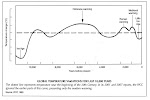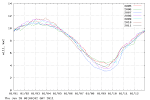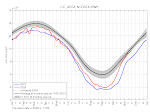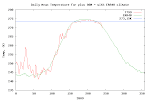In part two of this series we looked at the Mercury Hazard in CFL's. In this part we will examine the procedures for cleaning up a breakage and the procedures for disposal of CFL's when they have ended their life.
The US EPA has issued a series of instructions to do with the requirements of a cleanup should a Compact Florescent Bulb get broken. Here are their recommendations:
If a mercury bulb breaks in your house, it is now recommend opening windows immediately and evacuating the room behind closed doors for 15 minutes before attempting to clean up (if you leave it too long after that, however, the mercury can penetrate more of the surrounding area).
"In addition, data from this study suggest that venting should continue for several hours after a lamp cleanup to be conservative."
"Never wash clothing or other items that have come in direct contact with mercury in a washing machine, because mercury may contaminate the machine and/or pollute sewage. Clothing that has come into direct contact with mercury should be discarded"
If ‘direct contact’ happens, your clothes must be thrown out, in a sealed plastic bag, immediately.
"Never walk around if your shoes might be contaminated with mercury. Contaminated clothing can also spread mercury around"
"Never use a vacuum cleaner to clean up mercury." "The vacuum will put mercury into the air and increase exposure.”
It is recommended carpets exposed to a broken CFL bulb be ripped out , in order to protect the health of pregnant women, infants, children and the elderly or infirm:
"If clothing or bedding materials come in direct contact with broken glass or mercury-containing powder from inside the bulb that may stick to the fabric, the clothing or bedding should be thrown away"
Doesn't sound too "eco friendly" or "green" to me. More like Toxic waste.
Energy Mad, suppliers of Ecobulbs, recommend the following disposal options:
"If the bulb breaks – Air the house for about 10-15 minutes. Broken bulbs fragments should then be swept into a bag (don't vacuum) and taken to your local refuse station for recycling. Be sure to wear gloves to avoid being cut."
It is recommended that CFL bulbs are NOT used over carpeted areas, or where children play. Formally, the guidelines are that "homeowners consider not utilizing fluorescent lamps in situations where they could easily be broken, in bedrooms used by infants, small children or pregnant women, or over carpets in rooms frequented by infants, small children or
pregnant women.”
"Repeated exposures would presumably increase the probability of untoward consequences. In addition, the relative risk of various exposure metrics is unknown: whether the greatest risk is posed by short-term higher level peak exposures or by the total area under the curve including higher and lower exposures."
To further muddy the waters, the scientists note that the mercury contamination was considerably worse – nearly double in fact – at summertime temperatures (32C) than winter (23C).
When it comes to disposal of the waste there is another problem:
…the most up to date safety study available says plastic bags are next to useless for containing a broken CFL bulb.
"Double re-sealable polyethylene bags…did not appear to retard the migration of mercury adequately to maintain room air concentrations below the MAAG…
The best method of containing bulb waste is inside a glass jar with a hermetically sealed lid. Surprisingly, plastic jars, like large peanut butter containers with screw top lids were little better than plastic bags, also failing to prevent mercury vapour from leaking into the house. The scientific experiments proved that debris "sealed inside two polyethylene plastic bags and then placed in a clean room", sent atmospheric mercury levels up to more than three times the maximum allowable limit, for more than eight hours – the mercury vapour simply leached out of the bags into the air.
…The US scientists say it is possible that one single "spike" dose of mercury could be enough to damage a baby or a child's brain, even if there is no further ongoing exposure. With the experiments showing a 20 watt CFL (equivalent to 100 watts ordinary) bulb can produce a spike of 100,000 ng/m3 of air, 300 times the recommended allowable maximum, this could
be a major safety problem with making CFLs the light of choice when ordinary bulbs are banned.
…Recognising the toxic waste problem, Britain is examining recycling schemes. The cost, however, is prohibitive. One environmental agency report suggests it could cost US$1,300 to recycle one wheelie-bin full of CFL light bulbs. It's a cost that will ultimately fall on ratepayers.
One of the arguments often cited in favour of energy-saver bulbs is that although they contain mercury, they cut the amount of mercury being emitted by power stations because of the electricity they save. This is certainly true of coal-fired stations, which do expel mercury into the air as part of the coal-burning process. It is not true of hydro, however, because
hydro-stations don't generate mercury.
Regardless, it is one thing to have mercury vapour spewing out of a funnel into the ventilated open air. It is entirely different, and somewhat personal, to bring mercury back into an enclosed household in circumstances where the risks of breakage are very high. The chances of your child suffering serious mercury contamination from a coal-fired power station 200 kilometres away is almost nil. The chance of a child breaking a light bulb during a pillow fight, or knocking a lamp over during other shenanigans is quite high. And the chances of mercury hanging around in the bedroom carpet to cause chronic exposure is extremely high.
Yet how widely is this being advertised by our authorities who introduced these bulbs to our homes and lives compulsorily? Very little it would seem.
The question must be asked, in the attempt to be seen to be green, are we in fact introducing the asbestos of the 21st century to our homes and lives? Remember it too was once marketed as harmless and with positive benefits.
Subscribe to:
Post Comments (Atom)














No comments:
Post a Comment